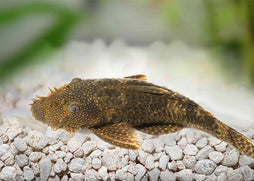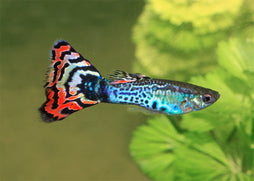Description
The Pterophyllum altum, often referred to as the "Altum angelfish," and "Orinoco Altum Angel" is a majestic and captivating species native to the slow-moving waters of the Orinoco and Rio Negro basins in South America. Recognized for its impressive size, elegant fins, and unique coloration, it is a highly sought-after fish for aquarium enthusiasts. However, due to its particular care requirements, the Pterophyllum altum is best suited for experienced aquarists.
Shop live aquarium fish online with confidence, with our livestock delivery guarantee.
Features of Orinico Altum Angel
-
Size: Grows up to 25 cm in length and can reach a height of 30 cm when fully mature.
-
Body Shape: Distinctively tall and elongated, with long, flowing fins.
-
Coloration: A pale, silvery body with vertical dark stripes that may vary in intensity.
-
Fin Structure: Large, long dorsal and anal fins, which contribute to its graceful appearance.
-
Temperament: Generally peaceful, but can be territorial, especially during breeding periods.
-
Lifespan: Can live for up to 10 years with proper care.
The Best Aquarium Size for an Orinoco Altum Angel
A minimum aquarium size of 250 litres is recommended for a single Pterophyllum altum, with larger tanks preferred for multiple fish. Given their large size and active swimming nature, a spacious tank allows them to move freely without stress, which is vital for their well-being.
After an Aquarium for your fish? Browse our Aquarium Tank Selection here
Tank Mate Compatibility for Orinoco Altum Angel
Pterophyllum altum are generally peaceful but can become territorial. When selecting tank mates, it is crucial to choose species that won’t provoke them. Ideal tank mates include:
Diet for Orinoco Altum Angel
Pterophyllum altum are omnivores and require a varied diet to thrive. They will accept a range of foods, including:
- High-quality flake food or pellets.
- Frozen or live foods like bloodworms, brine shrimp, and daphnia.
- Occasional vegetable matter like spirulina or blanched zucchini.
Browse our High Quality Fish Food online.
Aquarium Setup for Orinoco Altum Angel
Aquarium Filtration
Efficient filtration is essential to maintain the water quality in the aquarium. A strong external filter or canister filter is ideal to handle the tank’s biological load and ensure the water remains clear and well-oxygenated.
Browse aquarium filters here.
Aquarium Plants
While Pterophyllum altum are not particularly destructive to plants, it is best to choose robust species. Hardy plants like Amazon sword, Vallisneria, and Java fern are excellent options that provide hiding spots and help maintain water quality.
Interested in live plants for your aquariums? Browse live plants here.
Aquarium Lighting
Moderate lighting is recommended to simulate their natural habitat. A subdued light intensity mimics the shaded, forested waters where Pterophyllum altum originate. Providing some areas of dimmer lighting or shaded spaces will help them feel secure.
Need aquarium lighting for your fish tank? Browse our Aquarium Lighting.
Aquarium Heating
As a tropical species, Pterophyllum altum require stable water temperatures between 26°C and 30°C. A reliable aquarium heater is necessary to maintain these temperatures consistently.
Looking for a suitable fish tank heater? Shop aquarium heaters here.
Aquarium Substrate
A soft, sandy substrate is ideal to prevent damage to the fish’s delicate fins. Avoid sharp or rough materials that may harm them, and ensure the substrate is fine to allow the fish to forage naturally.
Shop a variety of Aquarium Substrates here
Aquarium Decorations
Decor should include driftwood, rocks, and caves that provide hiding spaces for the fish. These features mimic the natural environment, offering shelter while allowing ample swimming space.
Check out our huge range of Aquarium Ornaments














